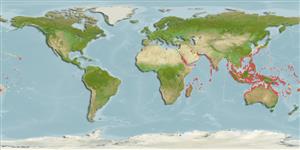Common names from other countries
Environment: milieu / climate zone / depth range / distribution range
экология
; пределы глубины 0 - 46 m (Ref. 75840). Tropical
Indo-Pacific: from East and South Africa, including Madagascar, the Red Sea and the Persian Gulf, to eastern Polynesia; north to Japan and Hawaii, and south to Queensland.
Length at first maturity / Size / Вес / Возраст
Maturity: Lm ? range ? - ? cm Max length : 7.5 cm SHL самец/пол неопределен; (Ref. 348); common length : 5.0 cm SHL самец/пол неопределен; (Ref. 348)
This is the most common Barbatia species of the Indo-Pacific (Ref. 2922). Attached by byssus among rocks, underside of coral slabs, or nestling in crevices. Littoral and sublittoral (Ref. 348). Also occurs in shallow areas of lagoons where it is attached to dead corals (Ref. 65033). Dead shells found on the beaches (Ref. 88739).
Life cycle and mating behavior
половая зрелость | размножение | нерест | икра | Fecundity | личинки
Members of the class Bivalvia are mostly gonochoric, some are protandric hermaphrodites. Life cycle: Embryos develop into free-swimming trocophore larvae, succeeded by the bivalve veliger, resembling a miniature clam.
Основная ссылка
ссылки | координатор | соавторы
Poutiers, J.M. 1998. (Ref. 348)
Статус Красного Списка МСОП (Ref. 130435)
Статус СИТЕС (Ref. 108899)
Not Evaluated
Not Evaluated
Угроза для людей
Harmless
Использование человеком
рыболовство: коммерческий
| FishSource |
инструменты
дополнительная информация
Возраст/РазмерыростЗависимость между длиной и массой телаЗависимость между длинамиморфологияличинкичисленность
ресурсы в Интернет
Estimates based on models
Preferred temperature
(Ref.
115969): 24.7 - 29.3, mean 28.5 (based on 3234 cells).
Уязвимость
Low vulnerability (10 of 100).
Категория цены
Unknown.
